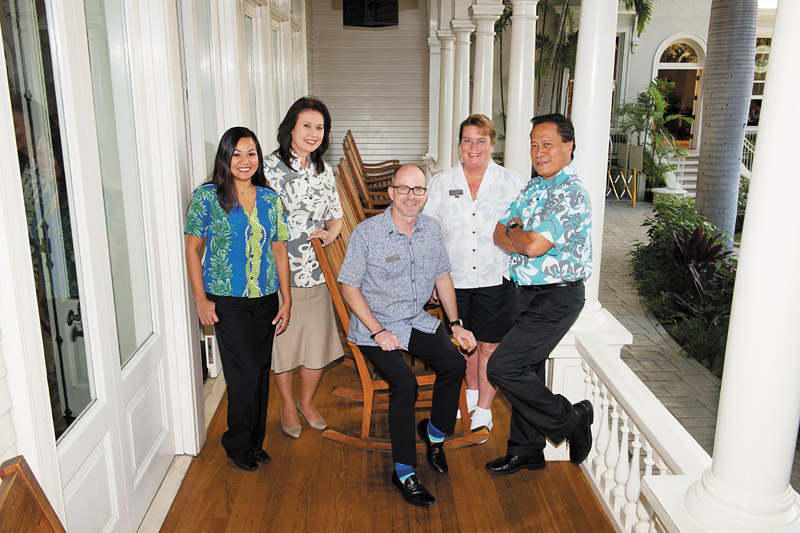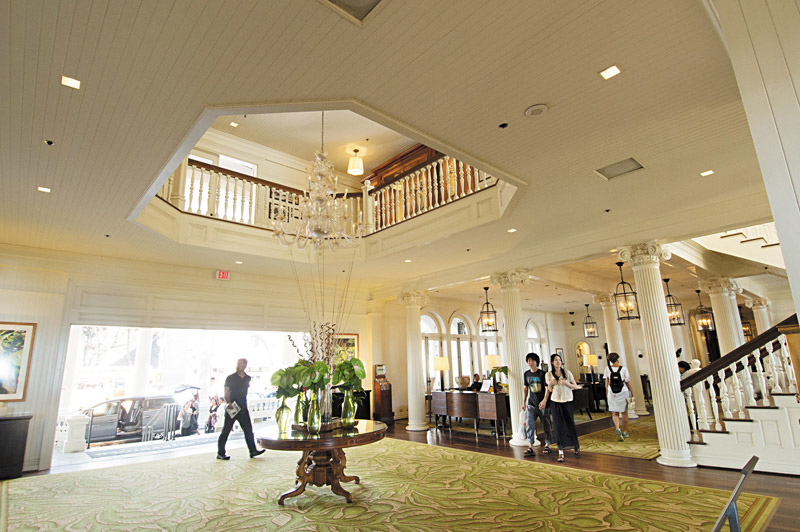The Moana Turns 115

It’s a magical place on Waikiki Beach, but what makes the Moana special is the people, including (from left) Roxanne Momohara, tour and activity consultant (13 years), Marian Lima, front desk supervisor (36), Larry Hanson, general manager (2), Nancy Gorospe, fountain dispenser (27) and Raul Tan, housekeeping supervisor (37)
How do you say thank you to a lady? Not just any lady, but the regal first lady of Waikiki, whose architectural features, historic sagas and rich memories define Hawaiian hospitality.
Celebrating 115 years, this lady deserves a toast to her remarkable endurance and economic vitality. She is the cornerstone of our tourism industry, yet often yields the spotlight to newer, splashy mega-resorts.
But today we return to the timeless elegance of the white hotel —Moana Surfrider, a Westin Resort & Spa at 2365 Kalakaua Ave. — because it symbolizes all that is alluring about Waikiki.
This is a tribute to the first lady of Waikiki that has inspired many stories and heart-felt memories of a classic era.
Listen carefully and you will hear voices of the past and present reveal Moana’s secrets to success. It has nothing to do with balance sheets, dividends and mass distribution.
It has everything to do with the soul of a place that inspires.
FOUNDER WALTER CHAMBERLAIN PEACOCK:
“In 1896, I proposed to build Waikiki’s first hotel as a solution to the area’s main drawback — the lack of suitable accommodations on the beach.
“My corporation, The Moana Hotel Company Ltd., commissioned architect Oliver G. Traphagen to draw up a plan to renovate the Peacock home and build guest cottages on the grounds. Construction began in September 1899 on a four-story, 75-room building. The Lucas Brothers, who built Iolani Palace, were the prime contractors.
“The hotel was an immediate success after its opening in 1901. Not bad for $150,000 in startup capital.”
ARCHITECT OLIVER G. TRAPHAGEN:
“My design of the Moana uses the Beaux Arts neoclassical style developed in France in the last half of the 19th century. Ionic columns support an elegant porte cochere at the entrance, leading to a lobby resplendent in detailed millwork.
“The coffered lobby ceiling is embellished with intricate plaster detailing. Each guest floor in the original building is furnished in fine wood — either oak, mahogany or maple — and each original guest room had a telephone and private bath, true innovations at the time.
“The Moana had Hawaii’s first electric-powered elevator (still evident in the lobby), as well as an ice plant and electric generators, impressive for that era in Waikiki.”
ARBORIST JARED SMITH:
“As director of the Department of Agriculture Experiment Station in 1904, I planted the banyan tree in the central courtyard to provide shade from the sun.
“The tree is a ficus, a member of the fig family originating from Bengal, India, where it is considered sacred by the Hindus.
“The banyan is a fast-growing tree that is easily propagated from cuts of itself and grows tall with a wide-spreading canopy. When first planted, the tree was 7 feet tall. It now stands 75 feet high, spans 150 feet and has a massive 40-foot trunk.
“In 1979, the banyan tree was among the first of Hawaii’s rare trees placed on the City & County’s Exceptional Tree List that preserves historic trees. It takes seven arborists several days to do its by-permit-only annual trimming.”
MUSICIAN JOHNNY NOBLE:
“I was the leader in 1918 of the house band known as the Moana Hotel Orchestra. Modern Hawaiian music was our specialty, and one of my first hits with co-writer Sunny Cunha was Hula Blues, written in 1920.
“After years of radio broadcasts, touring and composing music, I became director of entertainment at the Moana and Royal Hawaiian hotel. Harry Owens took over my band in1934.
“I developed hapa-haole compositions that mix traditional Hawaiian music and American ragtime (such as Little Brown Gal) that appealed to Mainland audiences. But the inspiration originated at the Moana.”
BROADCASTER WEBLEY EDWARDS:
“For 40 years, from July 3, 1935, I was the voice on radio that announced, ‘From the Banyan Court of the Moana Hotel overlooking beautiful Waikiki Beach, it’s Hawaii Calls!’
“An assistant ran out to the beach with a microphone to broadcast the sounds of the waves of Waikiki. The popular radio show reached more than 750 stations around the world and was a strong marketing lure for tourists.
“Among our regular performers were Alfred Apaka, Hilo Hattie, Haunani Kahalewai and Martin Denny.
“The Banyan Court today still rings with music and the conviviality of guests under the shade of the banyan tree. Aloha never looked or sounded so good.”
OWNER KENJI OSANO:
“In 1963, my company Kyo-Ya of Japan bought the Moana and Surfrider from Sheraton, following earlier ownership by Matson.
In 1989, I authorized a $50 million renovation by local architects Virginia D. Murison and Chapman Desai Sakata to restore the Moana to its original appearance. The two Surfrider buildings were incorporated to create a 781-room beachfront resort with a common lobby.
“The restoration received the President’s Award for Historic Preservation at a White House ceremony in 1992. The original structure is listed on The National Register of Historic Places, giving Moana a preservation and marketing cache that’s quite valuable.”
GENERAL MANAGER LARRY HANSON:
“The Moana has come a long way from the days when mule-drawn trolleys brought guests to the front entrance. The hotel’s first guests in 1901 were a group of 114 Shriners hosted by Aloha Temple Shriners. They paid $1.50 per night for their rooms.
“The warm welcome and attentive service they received, however, have not changed over the years. Our employees are our No. 1 asset, and sustain our resort’s consistency and personality. More than 25 percent of our workers have been with the hotel more than 20 years.
“Our goal is to connect to employees and to the community by keeping alive the history and music of Waikiki.
“There is a sense of calmness and cordiality that greet guests as they walk through our doors. This is the Moana’s finest legacy.”
EMPLOYEES RAUL TAN (37 YEARS OF SERVICE), MARIAN LIMA (36 YEARS), NANCY GOROSPE (27 YEARS) AND ROXANNE MOMOHARA (13 YEARS):
“Along with our general manager Larry Hanson (three years at Moana), our total time of service adds up to 115 years.
“It’s another world coming into our hotel from the outside. On this anniversary occasion, we invite friends and family to rediscover the Moana Surfrider, where Hawaii tourism originated and blossomed.
“Hear our music. Watch spectacular sunsets while sipping a beverage at Banyan Court. Experience high tea on The Veranda. Relax in our rocking chairs on the front porch or overlooking the banyan tree. You will be transfixed and transformed.”
DIRECTOR OF CULTURE THELMA KEHAULANI KAM:
“My role is to perpetuate the Hawaiian culture through guest activities, employee training and community relations. Three times a week (Monday, Wednesday and Friday at 11 a.m.), we offer free historic tours of the Moana Surfrider that include a panoramic view of the resort and Waikiki Beach from the private sixth-floor deck.
“The second-floor Historic Room has photos and memorabilia of Moana’s colorful history. We answer questions about the hotel and educate visitors and local residents about the heritage of this beautiful property, including about two friendly ghosts — socialite Jane Stanford and silent film actress Julia Moana Kuhn — who might tap you on the shoulder.
“And we dispel myths, such as the notion that Scottish writer Robert Louis Stevenson wrote poetry while sitting under the banyan tree. The truth is that Mr. Stevenson died in 1894. The banyan tree was planted in 1904. The famous essayist did spend five months on his Pacific journey in Hawaii, but he spent more time under the hau tree at Kaimana Beach. A plaque by our tree says it was originally planted in 1895, but not necessarily at the Moana. It may have first been planted at the Department of Agriculture Experiment Station on the outskirts of downtown Honolulu before coming to the Moana in 1904, but I cannot verify that. I just wish the tree could talk — imagine the stories she has to share!”
GUESTS RAY AND DARLEEN TUBBS, PITTSBURGH:
“While (Darleen was) recovering from a car accident in 1988, a friend recommended a Waikiki vacation. Unable able to get into The Royal Hawaiian hotel, we opted for the Moana. It was our lucky day.
“We have personalized car license plates that promote our favorite hotel. We often have to explain that ‘Moana’ is not the name of my wife. But we’re driven by the idea of being here every year.”
MAHALO MOANA
Say mahalo to the first lady of Waikiki at these anniversary events:
March: Moana Birthday Month. Specials at restaurants, bar, and Moana Lani Spa. Anniversary room package available.
Friday, March 11, 6 p.m.: “LOL. Love of Libations.” Diamond Lawn. Food and beverage pairings by Beach Bar, RumFire, Scratch Kitchen & Bake Shop, The Pig and the Lady, Koko Head Café, MW Restaurant, MAC 24-7 and Square Barrels. $75. Benefits Life Foundation-Hawaii chapter.
Friday, March 11, 6:30 p.m.: Slack key virtuoso Makana presents “Hawaii Calls” concert. $115. Benefits Bishop Museum, Historic Hawaii Foundation and Waikiki Aquarium.
Monday, March 7; Saturday, March 12: Artist in residence Juno Galang demonstrations and art exhibition. Main Lobby.
YOU:
Now it’s your turn to pay tribute to the first lady of Waikiki. Its rich heritage belongs to the people of Hawaii. Pay homage to this revered landmark on its 115th anniversary by making a visit to reflect on its history, appreciate its grandeur, and marvel at its wondrous craftsmanship.
Create your own Moana Moments and hope that local treasures like this endure for many more years to come so future generations can hear its voices.
NOTE: Mahalo to West Virginia-based author Stan Cohen, whose book “The First Lady of Waikiki” is a fine reference of Moana’s history.
PHOTOS BY NATHALIE WALKER







